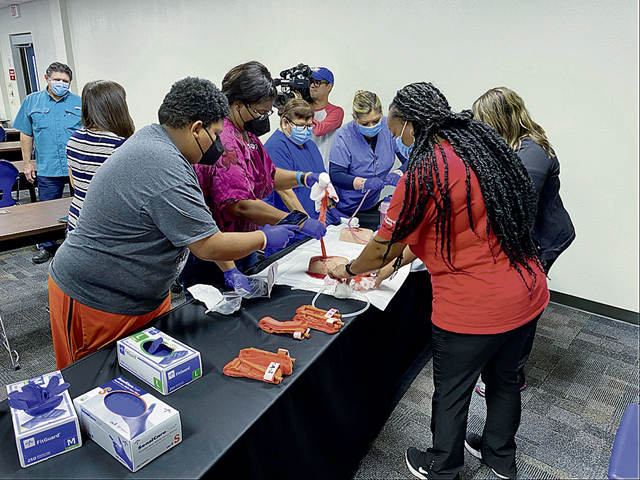
According to Bleedingcontrol.org, “uncontrolled bleeding is the number one cause of preventable death from trauma.” In San Antonio, there is an ongoing effort to train as many people as possible on how to control bleeding to increase the chances for victim survival.
Brandy Martinez, Brooke Army Medical Center injury prevention coordinator, together with a team from University Health, taught a series of Stop the Bleed courses to the general public at the Texas Department of Transportation district offices, May 19.
May is National Stop the Bleed Month, and the 19th happened to be Stop the Bleed Day.
The courses are designed to help people learn how to prevent deaths from traumatic bleeding. “I love to help people to feel empowered and confident that they could step in and save a life,” said Martinez.
According to the FBI, active shooter incidents in the U.S. have experienced a 52 percent increase from 2020-2021. With NPR reporting 198 mass shootings already in 2022, chances of being in one of these deadly incidents is becoming regrettably common.
On May 14, a gunman killed 10 people in Buffalo, New York, while two were killed and seven others wounded near a McDonald’s in Chicago. Martinez explained that anyone could find themselves in a situation where they are the first responder. “Bleeding emergencies can happen anytime, anywhere,” she added.
NOTE: At the time of this writing, an active shooting was in progress locally at Robb Elementary School in Uvalde, Texas, about 85 miles west of San Antonio.
The National Highway Traffic Safety Administration estimates that 42,915 people died in motor vehicle traffic crashes in 2021, a 10.5 percent increase from 2020, also a 16-year high. Transportation Secretary Pete Buttigieg described this as a crisis on America’s roadways. It is a crisis motorists can be prepared for to render first aid if properly trained to stop bleeding.
Knowing how to control bleeding from a serious injury is important knowledge for everyone to have. BAMC and University Health have been teaching courses together since late 2017, along with other members in the Southwest Texas Regional Advisory Council region. STRAC develops, implements and maintains the regional trauma and emergency healthcare system for the 22 counties.
Stop the bleed training at the TxDOT district office focused on the “ABCs” of bleeding:
A – Alert (call 9-1-1)
B – Bleeding (find the injury)
C – Compress (apply pressure to stop the bleeding)
Students participated in hands-on training, learning how to cover wounds with clean cloth or gauze and applying direct pressure with both hands, and how to apply a tourniquet. Additionally, they learned how to pack (stuff) a deep wound. At the conclusion of training, each student received a Stop the Bleed kit that contained a tourniquet, gauze, surgical gloves, marker, and a certificate of completion of the training from STRAC.
“I appreciate that BAMC gives me the opportunity to go out and teach in our community,” said Martinez. In addition to training community members, she provides required training for staff at BAMC.
University Health and BAMC are the only two Level I Trauma Centers supporting STRAC. One of the elements of Level I Trauma Centers is to provide public education to surrounding communities.
“We do education and outreach as a requirement for our ACS (American College of Surgeons) Level I Trauma verification,” she said. “We do train at BAMC on request for departments and individuals. We also hold regular training classes. Our next one is scheduled for June 15 at 2 p.m. in the BAMC orthopedic conference room.”
Martinez is motivated and passionate about the Stop the Bleed course and training as many individuals she can. She was very direct when asked why the training was so important.
“If we can prevent one death, then all of the work is worth it,” she added.


